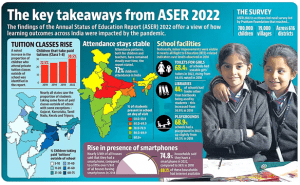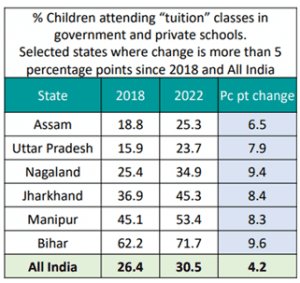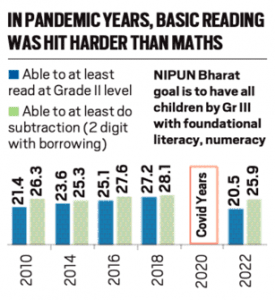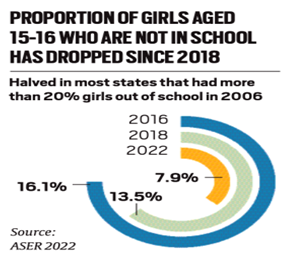THE CONTEXT: As schools reopened after nearly two years of closure due to COVID-19, student enrolments increased to more than pre-pandemic levels, but the learning gap widened for foundational skills in reading and arithmetic, reversing several years of improvement. This finding has been put forth by the Annual Status of Education Report (ASER) 2022, released recently by NGO Pratham. The following article aims to analyse findings of the ASER report from UPSC perspective.
WHAT IS THE ANNUAL STATUS OF EDUCATION REPORT (ASER)?
BASICS
- ASER (Annual Status of Education Report) is an annual survey of school education in India. It measures the basic reading and arithmetic abilities of children in rural India. The report provides data on enrollment, attendance, and learning outcomes.
- It is a nationwide survey of rural education and learning outcomes in terms of reading and arithmetic skills that has been conducted by the NGO Pratham for the last 15 years.
- It uses Census 2011 as the sampling frame and continues to be an important national source of information about children’s foundational skills across the country.
PREVIOUS ASER REPORTS
Previous ASER reports have highlighted issues such as low levels of learning, inadequate infrastructure, and high dropout rates.
- The first ASER was conducted in 2005 and repeated annually for ten years.
- In 2016, ASER shifted to an alternate-year cycle in which the ‘basic’ nationwide ASER alternated with a smaller survey (1-2 districts per state) focusing on other age groups and dimensions of learning.
- ASER 2017 reported on the activities and abilities of youth aged 14-18.
- ASER 2018 surveyed children in the age group of 3 to 16 years and included almost all rural districts in India and generated estimates of foundational reading and arithmetic abilities of children in the age group 5 to 16 years.
- ASER 2019 reported on the pre-schooling or schooling status of children in the age group 4 to 8 years in 26 rural districts, focused on the “early years” and laid emphasis on “developing problem-solving faculties and building a memory of children, and not content knowledge”.
- COVID-19 interrupted this alternate-year trajectory, and in 2020 and 2021 ASER pivoted to a phone-based format which tracked 5-16-year-old children’s access to remote learning opportunities in rural India.
- ASER 2020 is the first ever phone-based ASER survey and it was conducted in September 2020, the sixth month of national school closures.
ASER 2022
- ASER 2022 reached almost all rural districts of India, and generated district, state and national level estimates of children’s enrollment status and foundational skills.
- Information about enrollment in school or pre-school was collected for all children aged 3-16, and children aged 5-16 were tested one-on-one to understand their reading, arithmetic and English skills.
- ASER 2022 is the first field-based ‘basic’ nationwide ASER after a gap of 4 years. It comes at a time when children are back in school after an extended period of school closure.
- Evidence on the status of children’s schooling and foundational learning will help us understand how best to support them going forward, and ASER 2022 attempts to address this urgent need.
Key takeaways:
- The national-level study shows that despite school closures during the pandemic, the overall enrolment figures,
 which have been above 95% for the past 15 years for the 6 to 14 years age group, increased from 97.2% in 2018 to 98.4% in 2022.
which have been above 95% for the past 15 years for the 6 to 14 years age group, increased from 97.2% in 2018 to 98.4% in 2022.
- The proportion of children in this (3-16 years) age group who are not currently enrolled also dropped to its lowest level ever to 1.6% from 2.8% in 2018.
- Government schools have seen a sharp increase in children enrolled from 65.6% in 2018 to 72.9% in 2022, reversing another trend of a steady decrease in student enrolments seen since 2006, when it was at 73.4%.
- The percentage of children in Class 3 in government or private schools who were able to read at the level of Class 2 dropped from 27.3% in 2018 to 20.5% in 2022. This decline is visible in every State, and for children in both government and private schools.
- The percentage of girls in the age group of 11-14 years who were out of school declined to 2% from 4.1%. The decrease in the proportion of girls not enrolled in school is even sharper among older girls in the 15-16 years age group, which stood at 7.9% in 2022 as compared with 13.5% in 2018.
- According to the latest report, the availability of smartphones in homes of enrolled students has nearly doubled from 2018 to 2021, from 36.5 percent to 67.6 percent.
PRESENT STATUS OF EDUCATION: A COMPARISON WITH THE PAST
Since ASER 2022 is the first field-based ‘basic’ nationwide ASER after a gap of 4 years, i.e., 2018, here is a comparison of how education in India has been performing over the span of last 4 years.
Parameters 2018 report 2022 report Trend
Overall Enrollment (Age Group 6-14) 97.2% 98.4% Positive
Enrolled in Government School (Age Group 6-14) 65.6% 72.9% Positive
Girls not Enrolled in School (Age Group 11-14) 4.1% 2% Positive
Children in Std I-VIII Taking Paid Private Tuition Classes 26.4% 30.5% Positive
Children in Std III (Government or Private Schools)
Able to read at Std II level 27.3% 20.5% Negative
Children in Std III who are able to at least do subtraction 28.2% 25.9% Negative
Children in Std V across India who can do division 27.9% 25.6% Negative
Government Schools with Less than 60 Students Enrolled 29.4% 29.9% Negative
Average Teacher Attendance 85.4% 87.1% Positive
Fraction of Schools with Useable Girls’ Toilets 66.4% 68.4% Positive
Schools with Drinking Water Availability 74.8% 76% Positive
ASER 2022 REPORT: MAJOR TAKEAWAYS
- Number of students going for tuition has increased: Percentage of students attending tuitions outside schools have increased.
- The state with highest percentage of students going for tuitions is Bihar (71.7%), followed by Manipur (53.4%) and Jharkhand (45.3%).
- The exceptions are Gujarat, Karnataka, Tamil Nadu, Kerala and Tripura.

The math problem:
- Class 3 students who were able to do at least subtract dropped from 28.2% in 2018 to 25.9% in 2022.
- The proportion of children in Class 5 across India who can carry out division has also fallen slightly from 27.9% in 2018 to 25.6% in 2022.
- Nationally, the proportion of children who can do division has increased slightly, from 44.1% in 2018 to 44.7% in 2022.

Reaching out for the girl child:
- The percentage of girls in the age group of 11-14 years who were out of school declined to 2% from 4.1%.
- The decrease in the proportion of girls not enrolled in school is even sharper among older girls in the 15-16 years age group, which stood at 7.9% in 2022 as compared with 13.5% in 2018.

ASER 2022: ANALYSING THE QUALITY OF SCHOOLING
What could the corresponding increase in private tuition mean?
- The reason private tuition went up is probably that it is more flexible.
- Further, the pandemic left little scope especially for the vulnerable sections to afford online education.
- Also, there have been gaps in quality of teachers which somewhat creates a need for external assistance to the students.
- Further, as presently parents are either extremely busy or are not capable of tutoring their childrens, private tuitions have gained pace.
Have improvements in facilities like midday meals, toilets, etc. contributed to the increased enrollment?
- Over time, there has been an improvement in infrastructure variables.
- The issue of enrollments is coming potentially from the fact that during Covid, the rural private schools couldn’t do much because their own economy was very fragile.
- But being attached to the State, government schools distributed textbooks, and often distributed midday meals. All these aspects become pull factors for enrollment.
- Still, steps must be taken to ensure that cases of unhealthy or sub-standard midday meals should be avoided
What is the trend on foundational skills, emphasized in the National Education Policy of 2020?
- Almost 80 per cent of the schools reported that they have received guidelines regarding policies like National Initiative for Proficiency in Reading with Understanding and Numeracy (NIPUN) Bharat and Foundational Literacy and Numeracy (FLN) mission and teachers have been trained.
- This means that the seriousness with which governments are also sort of pushing on NIPUN Bharat is quite high.
- The National Education Policy of 2020 did well to emphasize importance of foundational literacy and numeracy. The Foundational Literacy and Numeracy Mission that follows from the policy is now leading the achievement of set goals. The policy also provides encouragement to change mindsets in the approach to school education. Going beyond policy, there are indications that governments are taking the Mission quite seriously.
EDUCATION IN INDIA: THE CONSTITUTIONAL MANDATE
The Constitution of India provides for the right to education as a fundamental right under Article 21A. This provision, inserted by the 86th Constitutional Amendment Act of 2002, makes education a fundamental right for children between the ages of 6 and 14.
Additionally, the Constitution of India also provides for the following provisions related to education:
- Article 45: The State shall endeavor to provide, within a period of ten years from the commencement of this Constitution, for free and compulsory education for all children until they complete the age of fourteen years.
- Article 46: The State shall promote with special care the educational and economic interests of the weaker sections of the people, and, in particular, of the Scheduled Castes and the Scheduled Tribes, and shall protect them from social injustice and all forms of exploitation.
- Article 51A(k): It shall be the duty of every citizen of India who is a parent or guardian to provide opportunities for education to his child or, as the case may be, ward between the age of six and fourteen years.
- Article 350A: It shall be the obligation of every State to provide adequate facilities for instruction in the mother-tongue at the primary stage of education to children belonging to linguistic minority groups.
These provisions, along with other laws and policies, provide the framework for the government’s efforts to provide universal and quality education for all in India.
ISSUES FACED BY EDUCATION SECTOR IN INDIA:
The education sector in India faces a number of challenges, including:
- Access: Many children, particularly those from marginalized communities, do not have access to schools or face barriers to enrollment and attendance.
- Quality: The quality of education in India is often poor, with low levels of learning and inadequate infrastructure. This is particularly true in rural areas and for schools serving marginalized communities.
- Teacher shortages: There is a shortage of qualified teachers in many parts of India, particularly in rural areas.
- Inequalities: There are significant disparities in access to and quality of education for different social groups, including children from low-income families, children with disabilities, and girls.
- Funding: The government’s education budget is inadequate to meet the needs of the education system, and there is a lack of investment in the sector.
- Inadequate evaluation and monitoring: There are a lack of effective evaluation and monitoring systems in place to measure the effectiveness of education policies and programs.
- Technological gap: Many students, teachers and educational institutes in India are yet to fully adapt to the use of technology in education, which can result in a lack of access to quality education resources and digital tools.
- COVID-19 Pandemic: The education sector in India has been heavily impacted by the COVID-19 pandemic. Schools have been closed for long periods of time, leading to disruptions to learning and uncertainty about the academic calendar.
These issues have a significant impact on the quality of education in India and the ability of students to achieve their full potential. Addressing these challenges is essential to ensure that all children in India have access to quality education.
THE WAY FORWARD:
There are a number of steps that can be taken to improve the performance of the education sector in India:
Increase funding for education: Investing more in education will help to improve the quality of education and increase access to schools, particularly in rural and under-served areas.
Improve teacher training and support: Providing better training and support for teachers will help to improve the quality of education and ensure that all students have access to qualified teachers.
Address infrastructure and resource gap: Providing schools with the necessary infrastructure and resources, such as classrooms, libraries, and science labs, will help to improve the quality of education.
Address disparities in access and quality: Targeted efforts are needed to address the disparities in access and quality of education for different social groups, including children from low-income families, children with disabilities, and girls.
Develop effective evaluation and monitoring systems: Developing effective evaluation and monitoring systems will help to measure the effectiveness of education policies and programs and identify areas that need improvement.
Embrace Technology: The use of technology in education can help to address some of the challenges facing the education sector in India. This includes the use of digital tools and resources to support teaching and learning, and the use of online learning platforms to reach students who may not have access to traditional schools.
Focus on quality and outcome-based education: Instead of focusing on the number of years of education, the focus should be on the quality of education and the outcomes achieved by students.
Encourage community involvement: Encouraging community involvement in education can help to improve the quality of education and increase access to schools. This includes involving parents, community leaders, and local organizations in the design and implementation of education programs.
CASE STUDY:
CHINESE APPROACH TO IMPROVING LEARNING OUTCOMES IN STUDENTS
China focuses on a multi-pronged approach unlike India which continues to focus on rote learning. Instead of exam-oriented education it is focused on student centered learning. While, Traditional education practices have expected students to passively accept and memorize material presented by teachers, and to reproduce the knowledge on often high-stakes examinations. The Chinese approach is designed to reduce teacher-centered instruction in favor of student-centered learning characterized by active learners creatively solving problems, challenging existing knowledge, and participating in lively discussion.
FINLAND
The Finnish education system is widely considered to be one of the best in the world. The country has a strong emphasis on teacher training, and teachers are highly respected and well-paid. The curriculum is flexible and student-centered, and there is a strong emphasis on equal educational opportunities for all students.
THE CONCLUSION: The role of education is to take the young to the cutting edge of knowledge and help society generate socially relevant knowledge. It is in this respect that India has fared mediocrely with not everyone getting to the frontiers of knowledge or generating socially relevant knowledge. Given the population size, even a small per cent is a large absolute number. While there have been learning losses, there has also been recovery once the schools reopened. Accounting for all the interim measurements, ASER 2022 estimates tell a story of recovery rather than one of loss.
Questions
1) While the 17th ASER Report (2022) tells a story of recovery rather than deterioration, there’s still a lot to be achieved to ensure, equitable access, inclusivity, and quality of education in India. Examine.
2) Enumerate the Constitutional Provisions regarding education in India. Discuss in the context of the ASER report, 2022, how far, the constitutional mandate regarding education is achieved in India.
Spread the Word
